(11.25.05) STEVE BRAND (the artist formerly known as Augur) makes obscure, organic music. His atmosphere, alarmingly austere, with varying shades of gray, are drenched in allusion and a heightened sense of cinematic noir for the listener. He’s been at it since the 1980’s but has been somewhat of a changeling. This interview attempts to unveil a few of those layers, delicately. I caught up with Brand at home in Kansas.
::..:::…..:..::….:::::..:::..:::::::……:::…::.:::….::::..:..:::…::…….:::::

TJ Norris :: It’s more than a pleasure to take some time to chat with you. Does this find you well and creative these days?
Steve Brand :: Thanks for asking. Yes, the last several years have been a time of real growth and development for me, emotionally, spiritually, and artistically. Unfortunately, like most people, these changes took place, at least in part, as a result of some personal challenges. Sometimes we just need a good kick in the ass to grow, I suppose. It’s been a time of transitions, life/death, jobs, health, etc. In that spirit, I have chosen to continue, and become more of an active participant in my own development and transitions as a Human Being. I’ve been doing a lot of reading, meditating, rumination and traveling which has resulted in lots of new art, music and new ideas for life in-general.
More practically, I’ve been working with Macs since the mid-80’s, but I’ve only recently transitioned my visual and sound work to computers with my recent purchase of a Powerbook, and I’m very excited about the possibilities and synergies this creates.
By the way, I currently have a track on a new compilation on Foundry called, Thing Asunder, with Michael Bentley, Earwicker and Ben Swire. An older work of mine that I originally did for a radio show out of London, One Hour as the One Who Watches, will be coming out on the Italian Blade label soon, and I was invited by Afe Records of Italy to contribute to an online compilation.
TJN :: Oh, I totally love what Afe has been doing, glad you hooked up with them, very homemade and yet, very prolific with a high quality, focused direction.
Right off, what are “digital paintings”?
SB :: Well, a convenient name. The digital paintings you’re referring to on my website and disk packaging these days, are digital collages of found objects and digital photos I’ve taken, and some manufactured images created with digital design tools. I suppose they are paintings in the sense that I create either a low relief composition or a landscape that these symbols and objects inhabit; consequently, there’s a lot of adjusting, blending, shading, and actual painting with the digital tools to make things work together. Some of these images are the result of just sitting down and working for hours, or quick intuitive groupings, and some are the result of what I think of as “delivered” ideas, that came in flashes during meditations. The paintings, in some cases, are continuations of ideas I was exploring 20 years ago, but with better tools that allow new kinds of possibilities in expression and feeling. I can’t say that I always consciously understand the symbols I use or manufacture, but they create and express a certain feeling about existence that feels very appropriate for me. Interestingly, but probably not surprisingly, I use much the same framework and aesthetics for creating my sound work… many of the same issues are involved… combining sounds, textures, atmospheres and feelings into new meanings. Alchemy, in short. (check website)
TJN :: Speaking of which, what actual tools and/or software are you using to make your latest recordings? Even though your work doesn’t say “digital” out loud to me, how has technology influenced how you work, especially over these twenty years… what’s changed?
SB :: Right now, I’m using GarageBand, a very simple and fun program that comes as part of the iLife suite on Macs. I’ll be headed to Logic soon. I have a pretty good Sony mic and lots of assorted objects and “instruments.” I occasionally use a Sony minidisk and a stereo Sony mic for sound gathering in the field.
About 10 years ago, I began using Avid digital video editing tools for my job, and it didn’t take long to realize how easy digital tools made some things, some of which took much longer to do analogue.
I’m glad that my music doesn’t sound too digitized to you; that wasn’t really what I was after. Sometimes, when an artist starts using a computer, I get the feeling of, “Oh, someone bought a computer.” It seems like there’s always a period of getting settled with the tools. I simply wanted to make the sounds I’d been making, but with the advantages of digital tools, which make things like EQ, effects, and mastering unbelievably easy. To be honest, I’m not really a technophile, I’m not passionate about the tools the way some folks are, but I like to stay abreast of developments that make sense for me to take part in.
TJN :: Tools are tools are tools.
Was Augur a prophet? Can you talk about any spiritual implications of your former work under this moniker and why the divorce?
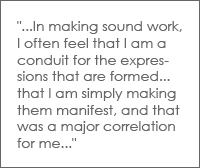
SB :: First, I dropped the Augur moniker because I had had it for so long, and as part of the changes I was going through, it seemed right to shed old ways of thinking; even though my work as Augur is relatively unknown to a lot of people, over time I was finding that I was a little confined by what my sound work was as Augur (by my expectations and the expectations of others).
At first, the name, “Augur,” was chosen in a purely intuitive way, but like most choices made in that fashion, I later began to realize the relevance of the name. According to most dictionary definitions, augurs were oracles in Roman temples whom people consulted to make life and death decisions. Historically, augurs were individuals charged with the responsibility of peering through the veil of this existence, with the purpose of bringing back information to people on this side. In making sound work, I often feel that I am a conduit for the expressions that are formed… that I am simply making them manifest, and that was a major correlation for me. Yes, I’m making a lot of conscious decisions in how to place and treat things, but most times, the initial ideas are the result of inspiration, and my job is to be true to, and give life to, the hints I get. There is still very much a need for this kind of deep spiritual communication in this world, even though modern society largely deems it to be hocus pocus.
TJN :: True, but the magic of sound is always on the periphery of something outside, something that draws us because of its difference from the everyday, or the containment of something very specific in time. As artists, we each create our own mantra, share it, establish our own boundaries, languages, for the few, or the masses, we speak our truth. Sometimes, our voices are meant to be heard by the few, those who take the appropriate access steps to reach our voice in middle-ground. What do you think?
SB :: I think I understand what you’re saying. Was it Van Gogh who said something like, the greatest work an artist can do, is himself? I feel this very deeply. I suspect, that our first audience is ourselves; honing the skills to follow our own voice and Guidance is part of that process, and whatever comes next is a result of, and in proportion to, that initial work. I also suspect that, even in making and having personal changes and revelations, ripples are sent out into the world resulting in larger change than we can realize.
People can be very passionate about the idea of exclusivity – either in favor of, or in opposition to. Personally, I would always like to share what I do with the widest audience possible, I have no desire to create my own little niche or fiefdom; however, at this time, there are sometimes other circumstances that dictate the size of that audience.
TJN :: How about your work as an artist. I hear you have not only been the maker of sound composition, but have also exhibited visual/fine art. Can you talk about that?
SB :: Ever since I was very young, I have drawn. My mother was a young teacher just learning about child development, so in a way, when I was a kid, I was her guinea pig. She saw that I had a real inclination towards art at a very young age, and really encouraged me to dive in with both feet, and bring these worlds I saw in my head into this reality. That extended to music as well… she tolerated a lot of bad garage band jams in our living room. Later, I was lucky enough to attend grad school, and explore art, myself, and life, even further. During grad school and afterwards, I was in a number of one-man and group exhibitions. I then moved back to Kansas City, and during that time (the mid-80’s), interesting galleries were almost non-existent… it was nothing like Chicago, the area I’d just left. Just the same, I continued to draw and create visual work, but also found that sound art was something I needed to be doing. These days, because I can simply go back and forth from a digital painting, to a sound composition on the computer, there’s a lot of bleed-through and synergy between the two for me. My intention for the near future is to find the right gallery to start showing these digital paintings.
TJN :: Your mother’s encouragement. Many artists do not have such support. Some who don’t can obviously become radical or rebellious. Sometimes, from a familial standpoint it has to be earned, as we know, making art only rarely has any tie-in to our world of commerce. What a gift your mom gave you!
SB :: Ask my mom, despite her encouragement, I was, and am, a rebel. Don’t misunderstand, it wasn’t always a warm and fuzzy environment for me as a kid – music and art were often a sanctuary from my everyday world; when my mother found out that I initially had no interest in college, but instead wanted to be a musician and artist, we had some major “disagreements.” Like most parents, she wanted what was best for me, but she wanted to create those boundaries and definitions, based on her own ideas of what was appropriate and safe. We all have circumstances of life that we wrestle with… consciously or unconsciously… that friction is what creates vitality and energy.
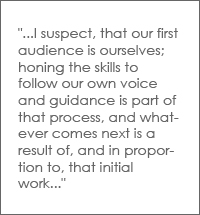
TJN :: Alright. Well, I am curious about the physicality of your work, often uniquely packaged, handmade, and in very small editions, mostly self-produced. What is the most important intent here, aside from the lovely sense of intimacy you allow the audience?
SB :: As I wrote above, I had been making sound and visual work as part of my own development for a long time, but during the early 90’s, with the help of Soleilmoon and Ozone in Portland (RIP), and Manifold in Memphis, I became aware of the work of Zoviet:France, Hafler Trio, Hands To (Jeph Jerman), etc., and I was inspired by the way they had created their own avenues of expression and outlets for that. They had largely broken away from the limitations of having other people pay for and release their music, and had done it themselves with beautiful results. Eventually, I contacted Jeph for more of his cassette releases, and that turned into a wonderful correspondence that took place over several years. At some point, I realized that I wasn’t only sharing my work, but communicating with people in places and in ways, that I could never have done previously; I was making connections with other people and myself, which is what art is all about for me. Also, the decision to create limited editions was a very practical one: if I wanted my work out there, I was going to have to do it myself, and so why not bring my other interests to bear to make a complete package in an affordable way.
Truthfully, in part because of the Internet, the days of imited disk releases might be numbered for me, and I would eventually like to be able to explore newer ways of getting my work to others, with the help of labels and like-minded individuals, via downloads, etc. I still feel that the a disk as an “object” is nice, but the Internet has replaced the old cassette network that used to exist, and now performs the same function.
TJN :: Old home week. Very cool about the Portland connection, I didn’t know that. Ozone is still around, it broke up into two separate shops by the previous two owners. What was it like working with Charles at Soleilmoon?
SB :: Actually, I should have written: “…with lots of “donations” on my part, and the help of Soleilmoon and Ozone in Portland (RIP), and Manifold in Memphis…” I was and am a complete music junky, and I bought A LOT of stuff through these outlets. They helped me become aware of what was going on out there in the world. Of course, I was a real privilege to eventually have my works produced and carried by these folks later.
I can’t say that I ever worked with anyone at Soleilmoon directly in any real way, so I can’t answer the question about Charles. I’m glad to read your news about Ozone!
TJN :: Collaborators truly fuse their separate vision. Can you talk some about the folks you have worked with in the past and what the process is like?
SB :: Collaboration is very interesting, because you get to explore avenues and methods that you might not otherwise explore on your own… we all get into our little hamster wheel mindset. It’s also a learning process, because you get to see someone else’s process and your own side-by-side at a very intimate level, and you get to ask yourself what is effective and what isn’t. Some collaborations have been very difficult because of entrenched attitudes on both our parts, some have been a little like ghost writing, some have been like putting a message in a bottle (I’m still waiting for the disk to wash ashore), and others have been a real meeting of the minds. Right now, my major collaborator is Jonathan Benham, a truly Creative person, and my “brother from another planet”; working with Jonathan is effortless, because we are coming from generally the same place emotionally and aesthetically, and there’s no pushing and shoving, since we have a lot respect for each others creativity. Working with him is more like remembering. I’d like to continue to collaborate, but with more like-minded people than I have in the past, because while I want to maintain an open mind, I have some very specific things I’d like to say with my music now.
TJN :: Right on. On your website you reference Isamu Noguchi. What is the connection?
SB :: Before grad school, when I was sticking my toe in the fine art waters, I was making up my mind if I wanted to explore a life of art-making. I just happened to catch (or was guided to watch) a television special about Noguchi, and I was very moved by the way his art both bonded with and sprang from Nature, and the way his creativity flooded every corner of his life; creativity wasn’t just a thing he did, it was the way he looked at life, and the things he created were a manifestation of that. I knew that was what I wanted for my life, so even though he has/had no idea who I am, I owe Noguchi. I still have lots of mentors like that, some of which will likely never be famous, but are giants to me.
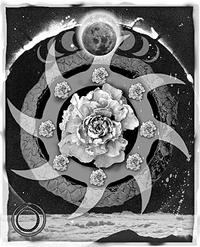
TJN :: Can you just briefly share a few of those folks with us and what makes them famous to you?
SB :: My father-in-law would be one, and a friend’s brother would be another. For instance, my father-in-law can blast a car, repaint it, re-wire your house, and afterwards, create a DVD on a computer that he has practically built from scratch. My friend’s brother was someone I’ll never forget; we went to meet him one weekend at his home in a relatively rural part of northeast Missouri. Of course, I had a lot of ignorant preconceived notions about what someone would be like who lived in a more rural area. I walked into the house, and could immediately see that he had remodeled the house to suit his own vision. I later found out he was an incredible artist, and a Civil War re-enactor who made his costumes and trappings… and not just kind of… everything was amazing. His family was also part of his creation, and so he had a rich family Life – his son and wife truly loved him, and visa versa.
As I wrote above, creativity was who they were/are, not just a thing they did to create a product. It was a revelation to me all those years ago, to realize that there are people who are unbelievably Creative in every imaginable way (in part, because they didn’t accept society’s limitations), and yet they might never be known for what they do… and that was not a consideration for them at all. Creativity was a wellspring inside of them that they openly shared with everyone.
TJN :: How does your personal geography act as a resource (or detractor), even if incidentally?
SB :: It always interests me, that people have to include in reviews, that I’m from Kansas: there might be a little self-consciousness here, but I get the feeling of, “Wow, he’s from Kansas and doing this work.” I have to admit, Kansas City isn’t thought of in any way as a hotbed of progressive art; that said, I have never really identified with Kansas City nor the Midwest in-general and its current culture, nor do I feel that I owe anything to Kansas City for who I am. Still, I have revisited this thinking over the years: KC can be a very insular place when it comes to creativity, and people here love their rock-n-roll; I can be a bit solitary, so I would say that creating in this vacuum has lent itself to my nature.
Speaking of nature… and history… I would add that the spare or subtle manifestations of nature here in this part of the Midwest have greatly influenced my work; there’s a lot of ancient and not-so-ancient history here that I have always been fascinated with, and I learn something new about it every day. The largest Pre-Columbian ceremonial center in North America, Cahokia, is only a few hours away from my home and I visit as often as I can, just to get reacquainted. Because nature is so subtle here (the only times we see an awesome display of nature are during weather events), so I love traveling to Arizona and Colorado to see just how overt nature can really be!
TJN :: OK, so we’re not in Kansas anymore, though I must say many places are as you describe, many large cities in fact, and smaller rural places, our world can have the power to expand and/or contract our form of expression or access to it. Though your work does not seem to suffer from the cons of this cultural shield, and actually has that sense of organic texture – that’s why I asked. Though what you do is much more physically far-reaching. So, beyond the studio, have you performed to a live audience?
SB :: Thanks for the Oz reference. No, I have not. I know some people think performing live as the pinnacle of achievement, but I haven’t felt the compulsion tp do that, since my garage band days. More practically, the opportunities to do that are few, and at present, I work for a living, so it demands a lot of my time than I’d like, but I think this will change soon. Luckily, Jonathan Benham and I have had some discussions about how to translate what we do to a live show, but that’s as far as it’s gotten. Lately, I’ve begun to understand that performing live is a different animal than sitting at home composing, and that it might be another way to make those connections I love so much. So, before I commit myself to performing, I want to put some thought into it, because if I were to perform, I’d like it to be compelling for an audience.
TJN :: And your day job is?… if you don’t mind me asking.
SB :: I’m a graphic designer for a motion picture exhibitor… for now.
TJN :: If you were to describe what you are after when you’re in the studio (or in the field) creating sound, what is it that you are after? Is there a general atmosphere you seek, a particular theme(s) or maybe some symbolic references?
SB :: Mystery and discovery. I love the idea that sound might be the purest kind of communication. Some people have said that they hear and see some darkness in what I do: to me, what they interpret as darkness is a love of mystery. I feel that what we are as beings, collectively and individually, remains in shadow for most of us, and works of art made with the intention of delving into those mysteries can be an aural map to lost knowledge. I see my art work as documents that are infused with the energy of that intent.
TJN :: Would you describe your work as ambient?
SB :: Sure, I don’t mind labels, because that’s how people get a handle on what you do, but I do object if the label becomes limiting. I just want my work to be a successful translation of the impetus that started it, and then people can call it whatever suits them, and it. I think my work used to fall into the “experimental” category, but as time has gone on, it can be thought of as “ambient,” or maybe “ethno-ambient.” Even though my work has changed, I think the common thread is my interest/investment in mystery, altered states of being, other times, and other cultures.
TJN :: I agree, I think labels and artists change with time, like fine wine.
SB :: Change is inevitable. Sometimes you see incredible enrichment as a result of change, and sometimes you can’t follow the person or thing through that change, but that’s just the way things work in this version of the dream.
TJN :: From whom do you seek reference, any role models?
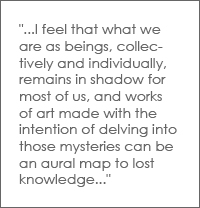
SB :: In-general, those who seek to seek, follow, and express their own vision, and actively and relentlessly work to open up to the world in ever increasing ways. For the last several years, I’ve been inspired by the work and words
of Steve Roach, Vir Unis, Robert Rich, Stefanno Musso/Alio Die, Michael Stearns, Ora, Jane Roberts/Seth, Carl Jung, Isamu Noguchi, Andy Goldsworthy, Robert Bly, Joseph Campbell, Gary Renard and Don Migel Ruiz. I want to say, I’ve been a fan of Steve Roach’s for a long time, but I have been fortunate enough to have a couple of very brief phone conversations with him, that really made an impression on me; not so much because of what we talked about, but because this guy, who is very well known and is extremely busy doing his work, took the time to answer his own phone, and have a casual conversation – which I see as an acknowledgement of the connection he has created with his listeners. That really impressed me, not to mention the fact that he has his own label, and continues to create work that challenges himself and fans alike. His work and ethic are an inspiration to me. I was also fortunate enough to see him and Byron Metcalf perform live for 4 hours in Tucson in early 2005.
TJN :: In 2002 I had a great interview with him, very grounding. As a matter of fact, I am just getting home from a trip to the outlying areas of Phoenix, I can see some of his inspiration: the land, vast, dusty, cragged.
Can you talk about your most recent work and what to expect in the near future?
SB :: I want to see that interview, TJ! Well, I’d say that this has been a time of incubation for me. I haven’t put out a lot of work, although I’ve created a great deal. I think this is a phase were the work is as much internal, and it is external. So, I guess you’d say, I’m getting settled in my new direction, and coming to terms with it. I think some of my new work is less cerebral and more emotional; more importantly, I think the new work is a distillation of the influences and themes I’ve always explored and mentioned above. Unintentionally, I also think the newer work is more accessible, more human, more extroverted. There are, and will always be, those sort of quiet private moments, but I think my emotional landscape has opened up to include more territory. I’ve talked about how I see the future above a little… Wow, well I can tell you what my intentions are: I am seeking to work with individuals and labels that promote and produce in an active way, and in addition, I would like to move away from the 9-5 world, to a more intensive involvement in creating art, and the activities supporting that.
TJN :: What is Life with a capital “L”?
SB :: You caught me. I love language! I’m making a distinction: an adjective as opposed to a noun. Sometimes I do this to make the distinction between the way the word/concept is commonly used and the way I’m currently using it.
TJN :: Speaking of language – go ahead and punctuate this conversation.
SB :: I just want to thank you for taking the time and interest to ask me for this interview. How about closing with a thought that I find powerful…
“You see and feel what you expect to see and feel. The world as you know it is a picture of your expectations. The world as the race of man knows it is the materialization en masse of your individual expectations. As children come from your physical tissues, so in the world your joint creation.” – Jane Roberts / Seth : The Nature of Personal Reality
::..:::…..:..::….:::::..:::..:::::::……:::…::.:::….::::..:..:::…::…….:::::
For more information about Steve Brand, visit his websiite here.










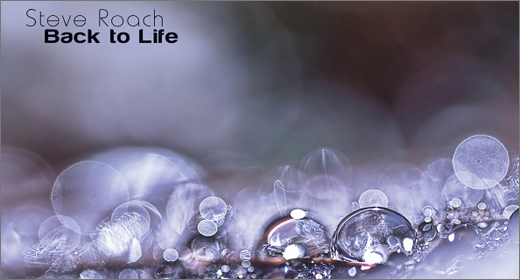

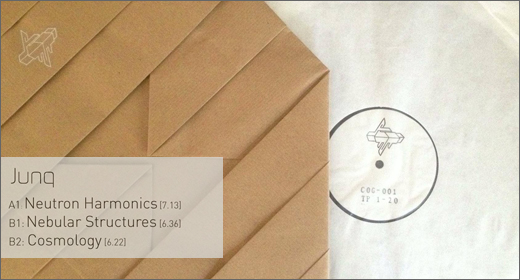

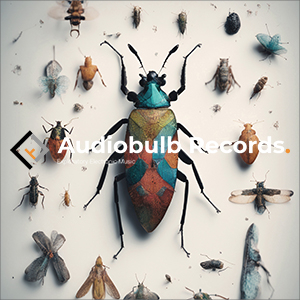


![Squaric :: 808 [Remixes] (Diffuse Reality) — [concise]](https://igloomag.com/wp/wp-content/uploads/2025/04/squaric-808-remixes_feat-75x75.jpg)






